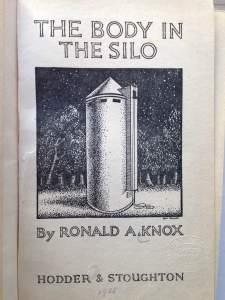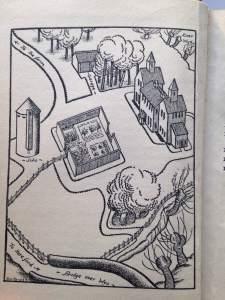
Title page, illustration by Bip Pares
As well as formulating the Ten Commandments of Detective Fiction or Decalogue, the Catholic priest and theologian Ronald Knox wrote six detective stories of which this is the fourth. All but the first feature Miles Bredon, an investigator for the Indescribable Insurance Company.
The novel opens with Miles and his wife Angela discussing an invitation they have received from Mr and Mrs Halliford, a couple they hardly know. Miles is suspicious, claiming that for some reason they have deliberately sought his acquaintance. As he says to Angela,
‘Why on earth do the Hallifords want us there? Why did they rout me out at the office and send us about six invitations to dine? We aren’t their sort; we don’t know the people they know.’
They accept and join an ill-assorted house party in rural Herefordshire. Mr Halliford is very proud of his new grain silo, which he delights in showing to his guests. Mrs Halliford likes to organize her guests and one night they play an ‘eloping game’, a variant on the treasure hunts of the time which involved driving about the countryside. The eloping couple keep their identity secret and, after a head start, the other couples set off to race them to an all-night garage at King’s Norton. The following morning one of the party, Cecil Worsley, is found dead in the silo, suffocated by the fumes generated in it. The verdict at the inquest is accidental death but Miles is not satisfied and he and Angela, along with their policeman friend, Leyland, do some unofficial investigating and work out what really happened. The murderer dies while setting the scene for a second murder.
There are definitely things to enjoy in this novel. It’s a combination of a witty country house novel and a detective story. It suffers from the facetiousness found in the lighter fiction of the time but there is a pleasantly satirical quality to Knox’s writing, often seen in the lists he is fond of using. Here he introduces the Indescribable,
‘The Indescribable is the insurance company, compared with which the other insurance companies all look like last year’s models. It was the Indescribable which paid up, merely for the advertisement, when a large hotel in South America took out a policy against earthquakes and was blown down, while in building, by a tornado; it was the Indescribable which underwrote the recent attempt to cross from Durazzo to Brindisi in a canoe; there was a rumour, but the thing was never acknowledged, that they were prepared to insure a belligerent minor state against all indemnities it would incur by going to war, only the League of Nations stepped in at the last moment.’
And here the coroner keeps tight control of the inquest in an effort to avoid scandal.
‘The eloping race, which might otherwise have made good copy for the sensational Press, was disguised as a “midnight expedition to King’s Norton,” as if that town were the Mecca of the sleepless.’
Nothing is treated seriously, even Miles’ rather feudal attitudes. He speaks scathingly of people who make money and ‘buy up the old houses where decent people lived before them’. He objects to them because ‘They play tennis with their rich friends instead of cricket on the village green with the blacksmith at one end and the second footman at the other.’ Angela mocks him affectionately for this.
And the fashionable treasure hunts and Mrs Halliford’s patronizing attitude are neatly skewered.
‘Of course, we went in for treasure hunts originally, but the neighbours were rather tiresome about it. Basil Freeland got one of the clues wrong, and dug up rows and rows of potatoes. They belonged to the sweetest old man in side whiskers and a square bowler hat, but he wasn’t a bit pleased.’
The conversations between Miles and Angela are characterized by wit and by greater equality than I had expected. Angela does play the Watson role but, far from being the ‘stupid friend of the detective’ referred to by Knox in his Ten Commandments, she does some investigating herself and contributes intelligently.

But what about it as a detective story? It has many of the elements of a Golden Age story: there is a map; there is a well worked out timetable with alibis to be broken; there are well planted clues; there is an ingenious murder method which verges on the grotesque; there is a pet monkey whose intervention confounds the murderer’s initial plans and the class system of the time is firmly in place. My difficulty is one I often find with detective fiction of the period and that is that the puzzle element is too dominant, while the characterization isn’t quite strong enough. Miles and Angela are reasonably vivid but the others are lightly sketched, not cardboard figures but just adequate for a non-serious novel. There are long interior monologues and conversations about the timings of alibis which seem unnecessarily dull and then Miles spends four chapters towards the end explaining to Angela and Leyland what happened and how he worked it out. They do discuss the murderer’s character and motives but this is overshadowed by lengthy talk about the timing and the mechanics of the murder, which involved getting the the victim to lock himself in the inner boot of a car. This boot is removable and was hauled up the side of the silo on a cradle and then decanted inside. It took several readings before I was clear about exactly how this worked.
Knox may have written his Decalogue with his tongue in his cheek but in this novel he seems to play fair. At one point I thought that Miles was having an ‘unaccountable intuition’ (forbidden in his sixth Commandment) but in fact he had noticed some minor anomalies. I enjoyed this novel although more for Knox’s writing than for the detective story; but it is certainly a cut above what Julian Symons called the Humdrum crime novels of the time.

